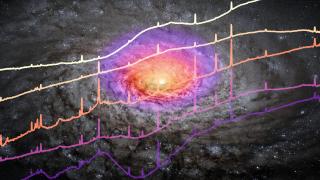Bibcode
Mejía-Restrepo, Julian E.; Trakhtenbrot, Benny; Koss, Michael J.; Oh, Kyuseok; den Brok, Jakob; Stern, Daniel; Powell, Meredith C.; Ricci, Federica; Caglar, Turgay; Ricci, Claudio; Bauer, Franz E.; Treister, Ezequiel; Harrison, Fiona A.; Urry, C. M.; Ananna, Tonima Tasnim; Asmus, Daniel; Assef, Roberto J.; Bär, Rudolf E.; Bessiere, Patricia S.; Burtscher, Leonard; Ichikawa, Kohei; Kakkad, Darshan; Kamraj, Nikita; Mushotzky, Richard; Privon, George C.; Rojas, Alejandra F.; Sani, Eleonora; Schawinski, Kevin; Veilleux, Sylvain
Bibliographical reference
The Astrophysical Journal Supplement Series
Advertised on:
7
2022
Citations
60
Refereed citations
54
Description
We present measurements of broad emission lines and virial estimates of supermassive black hole masses (M BH) for a large sample of ultrahard X-ray-selected active galactic nuclei (AGNs) as part of the second data release of the BAT AGN Spectroscopic Survey (BASS/DR2). Our catalog includes M BH estimates for a total of 689 AGNs, determined from the Hα, Hβ, Mg II λ2798, and/or C IV λ1549 broad emission lines. The core sample includes a total of 512 AGNs drawn from the 70 month Swift/BAT all-sky catalog. We also provide measurements for 177 additional AGNs that are drawn from deeper Swift/BAT survey data. We study the links between M BH estimates and line-of-sight obscuration measured from X-ray spectral analysis. We find that broad Hα emission lines in obscured AGNs ( $\mathrm{log}({N}_{{\rm{H}}}/{\mathrm{cm}}^{-2})\gt 22.0$ ) are on average a factor of ${8.0}_{-2.4}^{+4.1}$ weaker relative to ultrahard X-ray emission and about ${35}_{-12}^{\,+7}$ % narrower than those in unobscured sources (i.e., $\mathrm{log}({N}_{{\rm{H}}}/{\mathrm{cm}}^{-2})\lt 21.5$ ). This indicates that the innermost part of the broad-line region is preferentially absorbed. Consequently, current single-epoch M BH prescriptions result in severely underestimated (>1 dex) masses for Type 1.9 sources (AGNs with broad Hα but no broad Hβ) and/or sources with $\mathrm{log}({N}_{{\rm{H}}}/{\mathrm{cm}}^{-2})\gtrsim 22.0$ . We provide simple multiplicative corrections for the observed luminosity and width of the broad Hα component (L[bHα] and FWHM[bHα]) in such sources to account for this effect and to (partially) remedy M BH estimates for Type 1.9 objects. As a key ingredient of BASS/DR2, our work provides the community with the data needed to further study powerful AGNs in the low-redshift universe.
Related projects

Nuclear Activity in Galaxies: a 3D Perspective from the Nucleus to the Outskirts
This project consists of two main research lines. First, the study of quasar-driven outflows in luminous and nearby obscured active galactic nuclei (AGN) and the impact that they have on their massive host galaxies (AGN feedback). To do so, we have been granted time with the Gran Telescopio CANARIAS (GTC) in the optical and near-infrared ranges
Cristina
Ramos Almeida